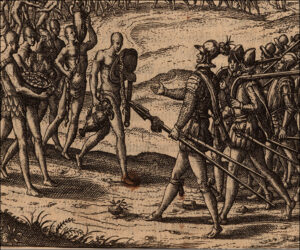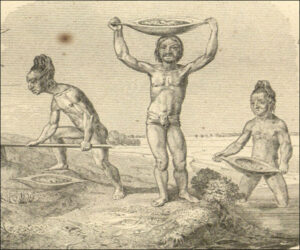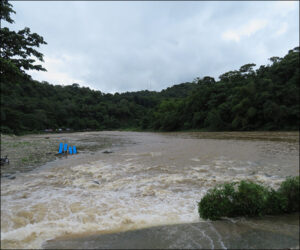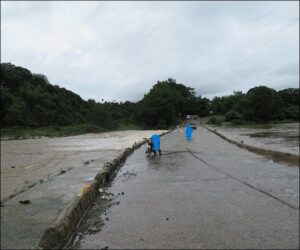A key expectation driving Queen Isabella and King Ferdinand’s conquest of “Española” was that Columbus would find and ship its gold home to them, as he promised repeatedly from 1493 to 1500. In 1499, placer gold was finally discovered in quantity in the watershed of the Jaina River northwest of Santo Domingo, an area I explored on my recent trip to the Dominican Republic.
In 1493, as related in Columbus and Caonabó, Isabella and Ferdinand envisioned that the island’s gold would be obtained through peaceful barter from its conquered “Indian” inhabitants and mining by Spanish miners using animal labor. When the Taínos resisted conquest, Columbus imposed an obligation to deliver gold tribute on chieftains in territory subjugated, which Isabella approved, envisioning the Indians’ tribute obligation akin to her Spanish subjects’ obligation to pay taxes (1495–1498). The first engraving below, which depicts conquest in Mexico, reflects this concept of tribute—conquered indigenous peoples are shown relinquishing gold jewelry and other gold items they possess, without being enslaved to mine gold (taken from Theodore de Bry, courtesy of the John Carter Brown Library, portion of rec. no. 0683-6).

From 1498 to 1502, as the next sequel will portray, the institution of gold tribute collapsed and the method by which Columbus and his successors extracted Española’s gold evolved into a system of forced Indian labor panning for gold in streambeds, then largely the upper Jaina and its tributaries. Columbus, the Spaniards who rebelled against him, and his successors, Francisco de Bobadilla and Nicolás de Ovando, influenced the cruel system’s evolution, and the doctrines of repartimiento and encomienda would come to justify it in a manner that superficially sidestepped the ban on enslavement of non-resisting Indians that Isabella imposed in 1500. The second and third engravings depict forced mining in the Caribbean (taken from Oviedo’s Historia General, courtesy of the Biodiversity Heritage Library, and from Pieter van der Aa, courtesy of the John Carter Brown Library, portion of rec. no. 08984-21, respectively).


The forced mining at the Jaina began under Columbus’s governorship, grew under Bobadilla in 1501, and substantially expanded under Ovando in 1502. Taínos were worked to death, which significantly contributed to their population decline. The photos show the Jaina near Madrigal (flooding its embankments on the day I visited), typical of where the forced mining occurred.



